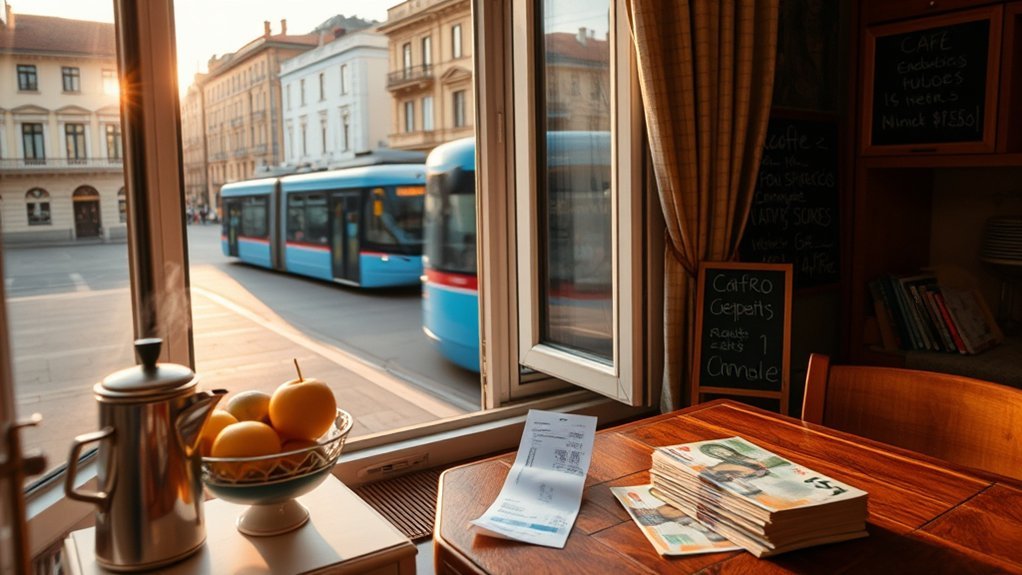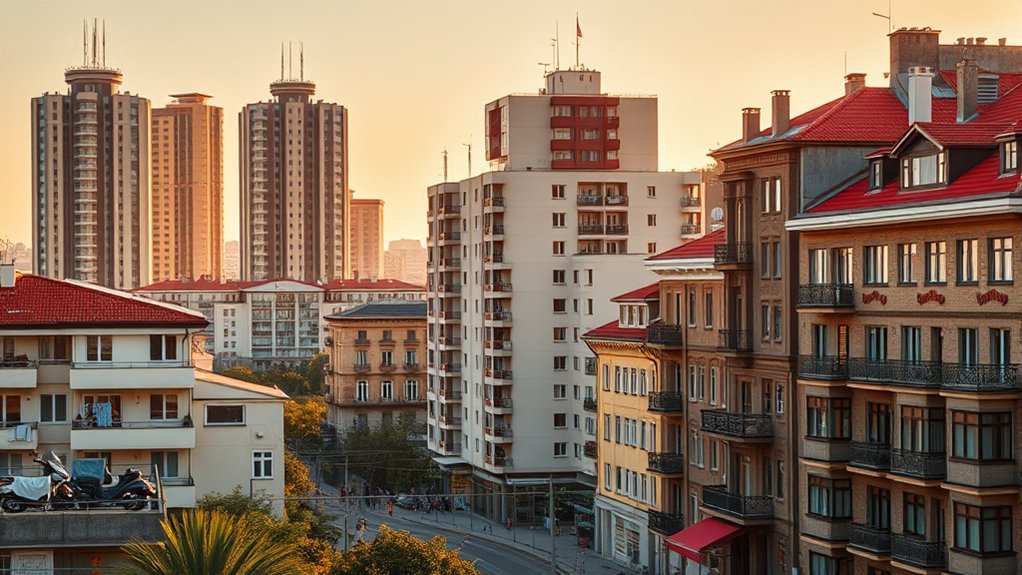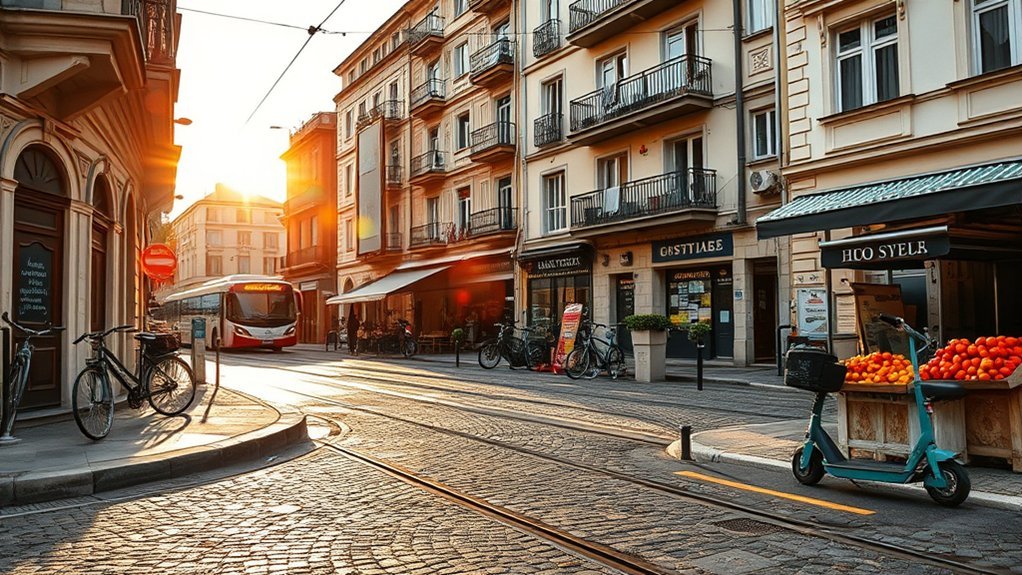You can live comfortably in Serbia on about $500–$1,000 per month, with central Belgrade studios typically $300–$600 and cheaper options on the outskirts or in Niš. Groceries run near $300 if you shop markets and cook, while utilities and internet add roughly $80–$150 monthly (higher in winter with electric heating). Public transit passes cost about $30, and eating out remains affordable—keep going to see exact city comparisons and saving tactics.
Monthly Budget Breakdown: Living Comfortably on $500–$1,000

You can live comfortably in Serbia on $500–$1,000 per month, depending on location and choices: expect around $400 for a studio or small one‑bed in major cities like Belgrade (cheaper outside the center), about $300 for groceries if you cook from local markets, utilities that can spike to $100/month in winter for a small apartment, and roughly $30 for a public transport pass—so a $1,000 budget sits well above the national average salary (~$600) and gives you clear room for savings or discretionary spending.
You can allocate budgets comparatively: at $500 you’ll prioritize lower rent or shared housing, cook most meals, and limit nonessentials; at $1,000 you’ll afford private housing, regular dining out, and modest travel.
This range maps to urban versus rural Cost of Living tradeoffs and seasonal utility variance. Use the average salary benchmark to gauge affordability: if your income nears the national average, expect tighter budgeting; above it, you’ll enjoy clear financial cushion.
Rent and Housing: Prices in Belgrade, Novi Sad and Niš

You’ll pay about $300–$600 for a one-bedroom in Belgrade’s center and roughly $100–$200 less on the outskirts, with studios or small one-bedrooms in major cities averaging $400/month.
Novi Sad sits between Belgrade and Niš on price, while Niš is clearly the cheapest option.
Choosing shared housing can cut individual costs substantially compared to private rentals, especially for larger or centrally located apartments (e.g., an 85 m² furnished place in an expensive Belgrade area rents for ~127,033 Дин vs ~73,231 Дин in a normal area).
City Center Vs Outskirts
Wondering whether to live in the heart of the city or on the outskirts?
In Belgrade, a city center one-bedroom apartment typically costs $300–$600; outskirts units run about $100–$200 cheaper, so you’ll save remarkably by moving outwards.
Novi Sad mirrors Belgrade but often trends slightly lower, making its outskirts even more cost-effective.
In Niš, one-bedroom rents are considerably lower overall, frequently under $300, so the center-versus-outskirts gap is smaller in absolute terms.
If you value central amenities and can accept higher rents—up to 127,033 Дин for large furnished units in pricey neighborhoods—you’ll pay a premium.
For strict budgets, Novi Sad outskirts or Niš center offer better per-month value without drastic lifestyle trade-offs.
Shared Vs Private Rents
How much can you save by sharing? Shared living options cut monthly housing bills sharply: one-bedroom apartments in central Belgrade run $300–$600, while outskirts are $100–$200 cheaper.
Choosing a room in a shared flat can reduce your cost well below the lower end for one-bedroom units. For example, a furnished 45 m² studio in an expensive Belgrade area is ~83,488 Дин; in a normal area it’s ~43,548 Дин, so splitting a comparable space halves your outlay.
An 85 m² furnished place in a normal area averages ~73,231 Дин — ideal for multiple occupants.
Novi Sad and Niš typically list lower rents than Belgrade, so shared options there yield even greater savings if you want private-style comforts at reduced cost.
Utilities, Internet and Monthly Bills

Although utilities in Serbia are generally affordable compared with Western Europe, your monthly bills can vary a lot based on heating and building services: water in Belgrade is roughly $20–$30, while building maintenance adds $5–$50.
Electricity depends on heating; if you use electric heating, winter bills can spike to $100–$300. Many buildings use centralized heating, reflected in infostan fees that range from $10 to $100 monthly, so compare heat types when choosing an apartment.
Internet is inexpensive by Western standards; an 8 Mbps plan is about $33/month.
Public transport is also cheap and predictable — a monthly pass in major cities runs about $30, giving unlimited buses, trams, trains and minivans.
Combine these costs to estimate recurring obligations: expect basic utilities plus internet and transport to commonly total between $88 and $243, with higher totals driven mainly by winter electric heating or upper-tier maintenance and infostan fees.
Food, Groceries and Eating Out Costs

You can keep monthly groceries near $300 by buying fresh, local produce at green markets (pijaca), where prices are often lower than supermarkets and bargaining is common.
Expect a combo fast-food meal to cost about 961 Дин (~$8.50) and a basic dinner for two in a neighborhood pub around 3,426 Дин (~$30), with typical restaurant meals falling between $11–$18 including drinks and dessert.
Tipping is appreciated but not required, so you can control dining costs by choosing markets and casual eateries over pricier restaurants.
Grocery Shopping Tips
When you shop in Serbia, you’ll find groceries are noticeably cheaper than in much of Western Europe or North America, so a monthly home-cooking budget around $300 is realistic thanks to plentiful fresh, locally grown produce.
Shop green markets and supermarkets to compare grocery prices; markets often beat chains on seasonal fruit, vegetables and dairy. You’ll use local culture to your advantage—bargaining at pijaca lowers costs and builds rapport with vendors.
Buy in-season and weekly to minimize waste and spend less per kilo. For occasional convenience, note that a fast-food combo runs about 961 Дин and restaurant meals average $11–$18 including drinks and dessert, so eating out remains an affordable supplement to home cooking.
Market Vs Supermarket
Having covered weekly shopping habits, it helps to compare green markets (pijaca) and supermarkets to see where your money goes.
You’ll find grocery prices generally low across Serbia, but markets often beat supermarkets on freshness and value. At the pijaca you can buy locally grown vegetables and fruit that are high quality and cheaper per kilo, which supports a ~$300 monthly home-cooking budget.
Supermarkets compete with steady discounts, packaged goods, and one-stop convenience, making them efficient for staples and bulk buys.
Use markets for seasonal produce to maximize quality and cost-effectiveness; use supermarkets for pantry items, dairy, and branded products.
Combining both lets you optimize taste, nutrition, and overall food spending without sacrificing quality.
Eating Out Prices
Although grocery shopping at the pijaca keeps your home-cooking budget near $300 a month, eating out stays surprisingly affordable: basic pub meals run about 3,426 Дин (~$29), fast-food combos about 961 Дин (~$8), and a dinner for two at an expat Italian spot averages 5,143 Дин (~$43), with typical restaurant meals (including drink and dessert) between $11–$18—so you can mix market-sourced ingredients and occasional dining out without dramatically raising food costs.
You’ll find eating out prices that let you sample Serbian food frequently without breaking your budget. Compare a 400 Дин (~$3.50) 500g pack of chicken to a pub meal and you’ll see value in cooking.
Fast food fills gaps; sit-downs offer higher quality for modest premiums.
Transportation, Healthcare and Other Essential Services

If you rely on public transit in Serbia’s major cities, a monthly pass runs about $30 and gives you unlimited access to buses, trams, and local trains, which is far cheaper than typical monthly transit costs in many Western European cities.
For transport by car, gasoline is roughly 191 Дин (~$1.67) per liter, so fuel costs stay moderate compared with Western averages; ownership costs will still add insurance and maintenance.
Utilities for a 45 m² studio (heating, electricity, gas) average 16,344 Дин (~$145) monthly, and internet (8 Mbps) is about 3,133 Дин (~$27).
Monthly utilities for a 45 m² studio run about 16,344 Дин (~$145), with 8 Mbps internet around 3,133 Дин (~$27).
On healthcare, a standard private doctor visit averages 3,428 Дин (~$30), making out-of-pocket primary care affordable versus private rates elsewhere.
Tips to Save Money and Find Affordable Accommodation

When you prioritize shared flats and neighborhood choice, you can cut housing costs dramatically—one-bedroom city-center apartments in Belgrade go for $300–$600, but sharing or moving to outskirts often halves that figure. Share a flat to split rent and utilities; a furnished 85 m² place in a normal area can be as low as 73,231 Дин monthly. Choose neighborhoods with good public transport to avoid car costs—monthly passes run about $30.
| Strategy | Impact |
|---|---|
| Sharerooms/roommates | Rent per person ↓ 40–50% |
| Move outskirts | Rent ↓ up to 50% vs center |
| Use pijaca + cook | Groceries ≈ $300/month |
| Monthly transport pass | ~$30; cuts car expenses |
Compare furnished versus central unfurnished options; furnished can save upfront setup. Buy essentials at discount stores, shop local markets for produce, and cook at home to control food costs. Track monthly spend to adjust housing or transit choices quickly.
Frequently Asked Questions
What’s the Average Rent in Serbia?
The average rent in Serbia’s major cities is about $400/month for a studio or small one‑bedroom; you’ll find Belgrade city‑center one‑beds $300–$600, cheaper outside, and Niš generally offers lower rents than Belgrade or Novi Sad.
Is Serbia Friendly to Foreigners?
Generally, it can be mixed: you’ll find warm, helpful locals and vibrant expat scenes, yet face occasional language, cultural, and service friction; compared to Western Europe, Serbia’s social openness varies more by city, age, and setting.
Can US Citizens Live in Serbia?
Yes — you can live in Serbia: you’ll enter visa-free for 90 days, then apply for temporary residence with accommodation, funds, insurance; costs and bureaucracy are generally lower and simpler than many Western countries, especially for IT professionals.
How Much Do You Need to Retire in Serbia?
You’ll need about $1,000 monthly for a comfortable retirement, though $600 covers basics; city rents run $300–$600, utilities $20–$300, and a more leisurely couple’s budget can reach roughly $3,000 monthly.
Conclusion
You’ll live pretty well in Serbia on $500–$1,000 a month — think a tidy studio in Niš versus a cramped Belgrade flat — because rent drives the numbers. Utilities, internet and groceries are cheaper than Western Europe, transport and healthcare won’t break you, and eating out is a bargain. If you want comfort, aim for the higher end; if you like thrift, the lower end’s realistic. Embrace local markets and shared flats — it’s basically survival chic.


